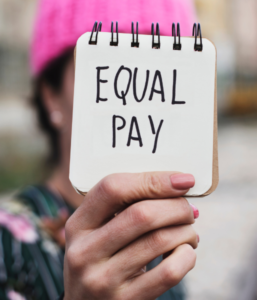Wednesday, March 24, 2021, is U.S. Equal Pay Day. This date symbolizes how far into the year women must work to earn what men earned in the previous year.
 It is a day for raising awareness of the gender pay gap (which indicates that on average, women earned $0.82 for every dollar men made in 2019), and the National Committee on Pay Equity (NCPE) ‘s appeal to employers, advocates, legislators, and individuals to help close the wage gap by getting involved.
It is a day for raising awareness of the gender pay gap (which indicates that on average, women earned $0.82 for every dollar men made in 2019), and the National Committee on Pay Equity (NCPE) ‘s appeal to employers, advocates, legislators, and individuals to help close the wage gap by getting involved.
This year, the date has deeper resonance as we come to terms with the impact the COVID-19 pandemic has had on women and that if we don’t take action now, we will see a disproportionally regressive effect on gender equality.
Businesses can take the first step towards tackling pay gaps and achieving pay equity by examining whether their H.R. and pay practices treat all employees equally.
Many are doing this through a full equal pay audit, and a WorldatWork and Korn Ferry 2019 Survey of Pay Equity Practices indicates that 60 percent of organizations are now taking action.
A complete pay equity audit can take time, but here are five quick check-ins you can do right now that will help to improve pay equity.
Do you disclose the hiring range during recruitment?
The talent acquisition process is a key touchpoint in the employee lifecycle. It’s the point at which an employee’s salary history with your company begins and can set the wage bar for the rest of a career, perpetuating any initial inequity.
Advertising roles with pay range data is a more transparent approach and can ensure offers are based on qualifications and where a candidate falls in range based on legitimate factors that should drive pay variance (like relevant qualifications, years of experience, and geography).
Having ranges out in the open means you can eliminate negotiation (where men tend to fare better than women) and also allow candidate self-screening from the process.
Do you apply the same rigor to setting pay for internal promotions?
Emerging salary history bans (that now exist in over 30 U.S. States) mean it’s no longer OK to ask for previous salary information from new hires. This legislation aims to tackle gender pay gaps by ensuring that low pay doesn’t follow women from job to job.
But the same principles can be applied to internal promotions or job moves, and many leading employers are extending this practice and not disclosing internal candidates’ pay. Again, rather than simply up-ticking salary on promotion by a small percentage, you give candidates the correct and fair rate for the job.
Do you measure bonus pay gaps as well as base pay gaps?
Pay Equity analysis often focuses on base-pay, but a study by ADP showed a vast percentage difference between female and male compensation originates from a difference in bonus pay.
Some of this is because when incentive pay is derived as a percentage of base pay, you just carry forward inequities that already exist. But also, wherever discretion is applied, there is an opportunity for biases to creep in.
That’s why it’s important to track bonus gaps as well. Even a simple count of bonus allocation by gender can be quite telling.
Have you considered whether performance criteria used to determine compensation have bias built-in?
Many compensation plans include performance metrics to bring rigor to reward allocation with the aim of removing subjectivity. But even this approach can fuel gender inequity.
Historically many schemes are based on metrics that, for all intents and purposes, rewarded the amount of time you spent in the office, be it billable hours or volume of output. Women, who more often bear the burden of caring responsibilities and work reduced hours, can simply be qualified out of achieving against such metrics.
Reviewing the criteria on which pay is determined to ensure each employee can contribute in a meaningful way is another tactic for maintaining compensation equity.
Are pay systems cloaked in secrecy?
All too often, how pay gets allocated and who gets paid what is cloaked in secrecy. But transparency in pay systems is essential in uncovering and addressing unlawful pay discrimination.
The more complex and less transparent a system is, the more vulnerable it will be to pay inequalities. But employers still feel uncomfortable disclosing pay ranges. If your processes are fair, you should have nothing to hide, and the right pay framework should be easy to explain because it obviously aligns with how you attract, retain and reward talent.
It’s easy for pay inequity to creep and spread across your business. A commitment to ongoing monitoring and evaluation is needed to make sure this does not happen.
On this Equal Pay Day, why not play your part and start a conversation internally on one of these check-ins!
Authors
Ruth Thomas
Ruth Thomas has over 30 years of global HR and reward management experience. A co-founder and senior consultant at CURO as well as an equal pay and DEIB advocate, Ruth is an expert in the management of compensation processes and the design of pay and benefit structure, salary progression systems, and management incentive plans. Ruth recently led the vision and development of CURO’s new pay equity solutions, including a U.K. Gender Pay Gap reporting tool and a global Pay Equity tracker. As one of CURO’s leading subject matter experts, she works with prospects and customers to help them optimize the execution of their reward strategy through technology.
Recruit Smarter
Weekly news and industry insights delivered straight to your inbox.





